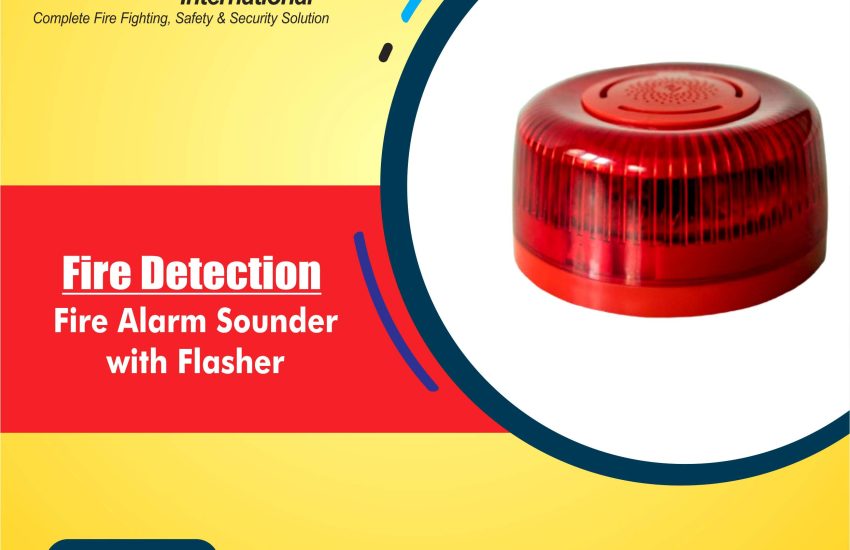Addressable Fire Alarm Sounder Flasher plays an essential role in modern fire safety systems. This device combines audible and visual alerts to notify occupants about fires or emergencies. This guide covers the key features, uses, benefits, installation tips, and maintenance practices for the addressable fire alarm sounder flasher.
What is an Addressable Fire Alarm Sounder Flasher?
An addressable fire alarm sounder flasher integrates both an audible alarm and a visual flashing light. It alerts people to a fire, ensuring they can react quickly. Unlike traditional systems, addressable fire alarm systems assign unique addresses to each device. This allows the control panel to identify the exact location of the triggered alarm.
By using addressable technology, fire alarm systems provide more efficient monitoring and faster responses compared to conventional systems.
How Does an Addressable Fire Alarm Sounder Flasher Work?
Here’s a simple breakdown of how the addressable fire alarm sounder flasher operates:
- Signal Detection: The fire detection system sends a signal to the sounder flasher when it detects smoke, heat, or any other fire indicator.
- Audible Alert: The sounder emits a loud siren or bell to alert everyone in the area. This sound is designed to be heard over background noise.
- Visual Alert: The flasher emits a bright light to ensure that everyone, including those with hearing impairments, notices the alarm.
- Addressable Identification: The fire control panel can identify which sounder flasher was triggered. This helps responders locate the fire’s exact location quickly.
Key Features of an Addressable Fire Alarm Sounder Flasher
Addressable fire alarm sounder flashers have several important features:
- Dual Alerts: The device emits both sound and light, making it easier for people to notice the alarm.
- Addressable Technology: Each device has a unique address, allowing the control panel to pinpoint the alarm’s location.
- Energy Efficiency: These devices consume less power, making them more reliable during power outages.
- Adjustable Volume: The sound volume can be adjusted to suit the environment. For instance, in noisy areas, you can increase the volume.
- Weatherproofing: Some models are weatherproof, ensuring reliability in harsh environments.
- Compatibility: These devices are designed to integrate with other fire safety equipment, such as smoke detectors and heat sensors.
- Customizable Flashing Patterns: Certain models allow you to customize the flashing patterns to suit different types of alerts.
Common Uses of Addressable Fire Alarm Sounder Flashers
Addressable fire alarm sounder flashers are versatile and used in various settings. Here are some common applications:
1. Evacuation Alerts
The primary function of the addressable fire alarm sounder flasher is to alert building occupants of a fire. The combination of sound and light helps people respond quickly and evacuate safely.
2. Noisy Environments
In environments such as factories, warehouses, and large buildings, background noise can drown out traditional alarms. The audible sound and flashing light ensure everyone notices the alarm.
3. Assisting People with Hearing Impairments
The flashing light is especially important for people who have difficulty hearing. This visual indicator ensures that everyone is aware of the emergency.
4. Industrial and Commercial Spaces
Addressable fire alarm sounder flashers are particularly useful in industrial or large commercial spaces. Their addressable feature allows the fire control panel to quickly identify the fire’s location, speeding up emergency response.
5. Large and Complex Buildings
In multi-story buildings, these devices help locate the fire, allowing for more efficient evacuation and a faster emergency response.
Benefits of Addressable Fire Alarm Sounder Flashers
The addressable fire alarm sounder flasher offers several key advantages:
- Faster Response Times: Since the system can pinpoint the exact location of the fire, emergency responders can act quickly.
- Increased Safety: The combination of sound and light helps ensure that everyone is alerted, including those with hearing impairments or in noisy areas.
- Efficiency in Large Spaces: The addressable feature improves response times in large facilities, reducing confusion during an emergency.
- Cost-Effectiveness: While the initial installation may cost more than traditional systems, addressable systems offer better long-term value due to lower maintenance and easy expandability.
- Regulatory Compliance: Many fire safety regulations now require addressable fire alarm systems. Using addressable sounder flashers helps ensure compliance with these rules.
Installation Tips for Addressable Fire Alarm Sounder Flashers
Proper installation is essential for optimal performance. Here are some helpful tips:
- Install in High-Traffic Areas: Place sounder flashers in areas like hallways, stairwells, and near exits to ensure they are visible and audible to everyone.
- Correct Height: Install the devices at a height of around 2.5 to 3 meters to ensure the light is visible and the sound is heard clearly.
- Avoid Obstructions: Make sure there are no obstacles blocking the sound or light. Keep the devices free from furniture or walls that could obstruct them.
- Connect to the System: Ensure the sounder flashers are connected to the fire alarm control panel and other fire safety devices, like smoke detectors and heat sensors.
- Perform Regular Testing: Check the sounder flasher’s functionality regularly. Test the volume, light output, and the connection to the fire alarm control panel.
Conclusion
An addressable fire alarm sounder flasher is a crucial component of any fire safety system. By combining audible and visual alerts, it ensures building occupants are quickly notified in case of a fire. The addressable feature provides faster response times and more accurate identification of the fire’s location. These devices are useful in noisy environments, for people with hearing impairments, and in large buildings. Proper installation and maintenance will ensure that the device works effectively and remains compliant with fire safety regulations.


